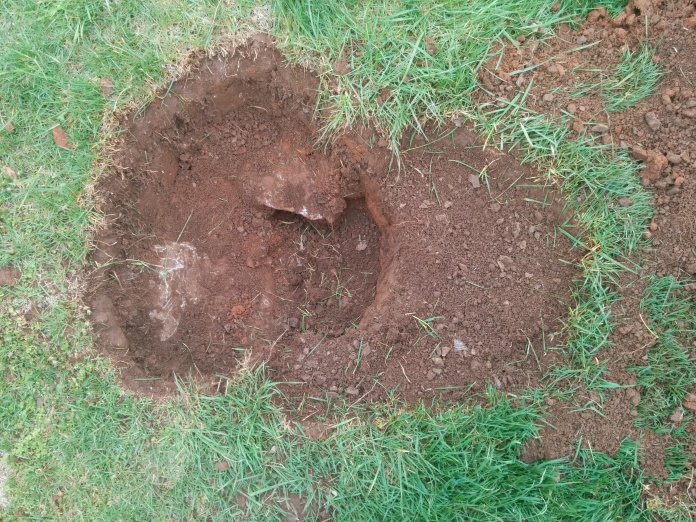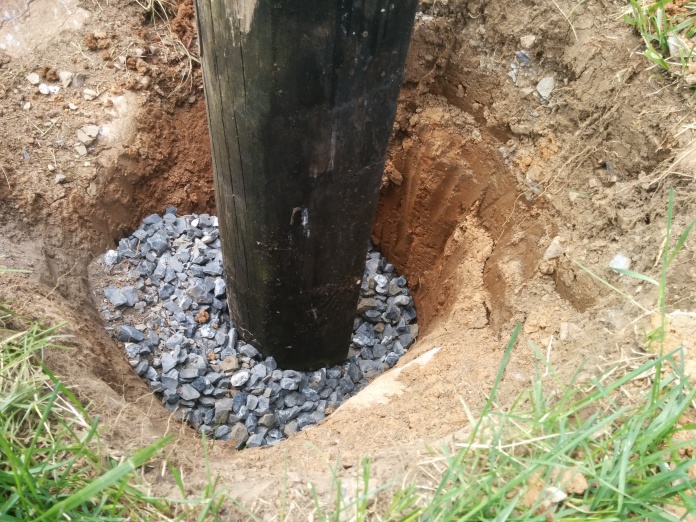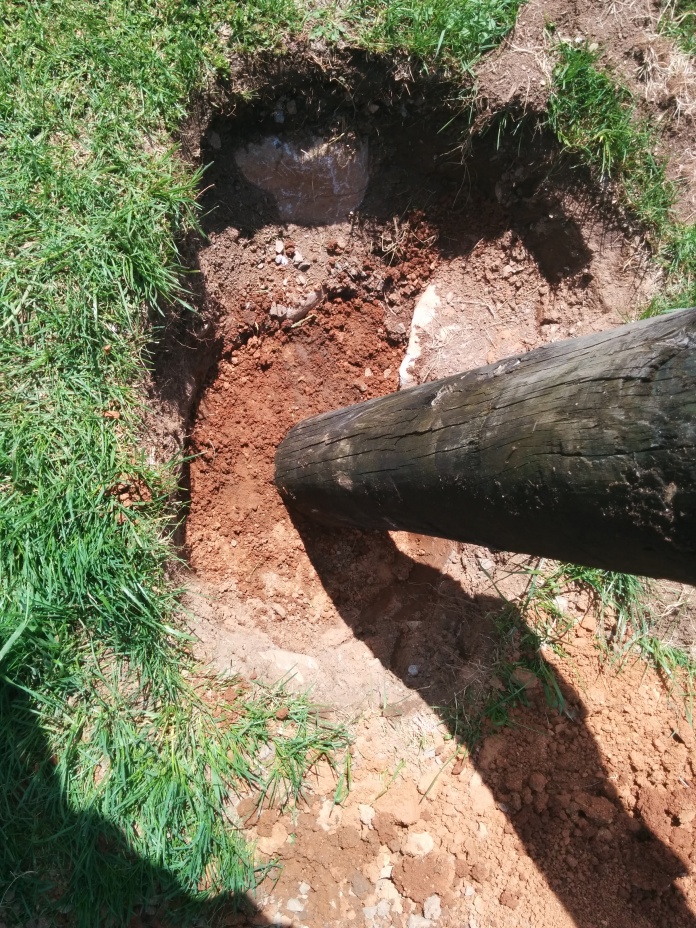At 15 and eager to find my first real job, I followed up mercilessly on an application I submitted to a farm/county park that was an easy bike ride away. Eventually they gave in and granted an interview.
Over the course of the next few years, my interviewer and subsequent first boss turned out to be an individual with a work ethic beyond anyone I have ever met and without a doubt will ever meet in my lifetime. The man was just a workhorse and at such an impressionable point in my life, it turned out to be a great influence and helped shape me into what I am today. Unfortunately he died far too young but I try my hardest to remember the many things that he instilled in me.
Setting fences posts was one such task that I got to observe and learn from him. In fact, those that he set at the farm always outlived the need for a fence in that location.
Assumptions you should be aware of:
This is valid for locations with clay subsoil and a climate unlike that of the Pacific Northwest with its combination of high water tables and wood devouring soil microbes.
Items Required
Digging iron with a tamping end (example)
Spade shovel
Post hole digger, but I just use the spade and my hands and omit this tool (example)
Tarp or splayed feedbag- something sturdy enough to hold and manipulate the dirt you excavate
Fence Post
Gravel
Extra dirt, the more clay content, the better
Discarded paint can lid or similar (See step 15 for its purpose)
Procedure:
- Find a concrete surface and lightly tamp your digging iron against it. Memorize this ringing sound!
- Remove the turf and topsoil from the site of the post. Discard- I use this to cover exposed limestone rocks in the unimproved roads on the farm.
- Dig the hole putting the displaced earth onto the tarp.
- For depth, shoot for 25-30% of the above-ground length of post so 2 feet buried for a 7 foot post (5 feet exposed).
- Add 4 additional inches to this depth. So for a 7 foot post to be buried 2 feet, dig a 28 inch deep hole
- Dig twice the diameter of the post.
- Pour 4 inches of gravel into the hole.
- Place the post in the hole. If working solo, a brace may be required to hold it upright.
- Add another 2 inches of gravel around the base of the post.
- Level the post at this point! From here on out, the post isn’t going to budge.
- Add a few inches of the clay soil by shovelling or pouring from the tarp.
- Now tamp tamp tamp until the sound resembles that which you memorized in step 1.
- tamp some more for good measure
- Repeat steps 8-10 until tamped clay around post is at level with the ground. This takes at least an hour depending on the moisture content of the clay and it is vitally important to take your time. No shortcuts!
- Tamp it real hard for good measure
- Repeat steps 8-10 forming a cone of clay 2 or more inches high around the base of the post.
- Tamp this cone until it rings like concrete.
- Attach a paint can lid or similar water barrier to the top of the post
Justification
First of all, I can barely do 1 post a day and my arms are numb from the tamping while my first boss could do 4 or 5. But from here on out, the post will last until the wood degrades above ground. Luckily that is a variable that we control and can stave off with sealants or paints.
Why do gardeners, ecologists and arborist warn against the effects of soil compaction on plants? Compact soil is biologically dead and impervious to water. Both attributes prohibit vegetation from becoming established. More importantly, a lack of microbes, oxygen and water prevent the wood from deteriorating underground! While soil compaction is a bane to the farm in most circumstances, it has its rightful applications. The role of the gravel is insurance providing drainage in the instance that water somehow finds its way in allowing to to seep deep into the ground. The cone at the base of the post rising up above ground level should shed all water anyway if compacted enough.
Pictures of the process
Note that I ran out of extra dirt. This will be rectified once I find a source of dirt that is not meant for top soil. It will likely come from other projects on the farm that require light excavation.
Also the damn limestone ledges everywhere on the farm made me have to keep moving my hole after starting to dig it out before I could reach the needed depth! No fence post hole will likely ever have to be this large in diameter.
Gravel added 4 inches below the post and 2 inches around its base
Getting it level with the gravel
Adding dirt little at a time and tamping like crazy! Arms are already like jello at this point
Now they are alarmingly numb, but must push through!
Finally finished. Well almost. Need to get more clay to finish the water shedding cone which I elected to build on the uphill side of the post with the dirt available.
A warning
This fence post is never going to move. Make sure you adequately plan the fencing for this permanence. If it has to be removed, short of major earth moving, it will likely have to be with a chainsaw leaving a stump like a tree. And that stump probably won’t decompose in our lifetime!
One last unrelated note:
I obtained these lightly used fence posts from a farm for $1.50. Items like fence posts can be had opportunistically for deep discounts. Stock up when presented with a cheap opportunity!
I know its strange to mention a fashion blog dedicated to quality clothing in the context of this blog. However putthison.com created this extremely accurate depiction of sourcing quality goods:

You can get items of good quality EITHER quickly OR cheaply but not both.
By the time a fence is a high and pressing priority, posts are not likely to be cheap. And if they are, I doubt they are cedar, mulberry, locust or osage orange which are the absolute best woods to be sunk into the ground. But who knows, with this method, you might be able to get away with a rot-prone wood!








I’ve seen people do this with just gravel and no clay whats the benefit of using some clay instead of purely gravel?
LikeLike
Actually, if you don’t use concrete, you can actually easily pull posts out of the ground using a hydraulic auto jack with a chain and large lag bolts. Take about 18 inches of chain. Lag bolt each end to opposite sides of the post just above the ground. Use the jack to pull the post straight up out of the ground. Unless the wood is badly rotted, works every time. Works with concrete too but takes more effort.
LikeLiked by 2 people
Hi, I’d be really interested in your thoughts on our FenceFins product. Been on sale in the UK for several years but only recently available in the US. Basically it will save alot of the digging you had to do in terms of the size of the hole (but not the depth, we’re with you on the need for that). And, just like you do, the dirt is tamped down firmly. But because the hole can be smaller there’s just not quite so much of it to do! Really love to hear your thoughts if you have a few minutes. You can contact me through our website at http://www.fencefins.com
LikeLike
The gravel bed is going to have the inverse effect of what you are looking for — the large porosity of the gravel can’t pull water out of the tiny pore spaces of the clay, so the clay will saturate before the wetting front moves into the gravel bed.
LikeLiked by 1 person
I used the same technique putting in dozens of power and lighting poles when I was in the Air Force working as a high-line electrician. No leftover dirt but occasionally rocks left out if they were too big to fit in the hole. Three fast tampers, one slow shoveler.
LikeLike
What’s up,I read your blogs named “How to set a long lasting fence post without concrete – thegreenergrassfarm” regularly.Your story-telling style is awesome, keep it up! And you can look our website about free proxy.
LikeLike
Thanks for sharing this! My late grandfather used to tell me to never use concrete in a post hole and I couldn’t recall how he explained the “correct” process. Until now I hadn’t even heard of anyone else use a sans-concrete method to install fence posts.
LikeLike
Ontario Hydro have a modified method 1, dig hole below frost line 2, line hole with corrugated drainage pipe 3to4 times post dia. 2“ above grade. 3, some gravel at base back fill around pipe with soil and tamp 4, insert post & center. 5, back fill with 1/2“ crusher gravel. GO HOME!! Oh did you make a mistake, use an industrial shop vac. to remove gravel. repeat from step 1.
LikeLike
Thanks for this, my wife wouldn’t believe me when I said we never used concrete when I was a kid on the farm. Really like the idea of the cone at the top 🙂
A shortish scaffolding (say 4′) pole makes a really good tamper, then end soon fills up. Your effort goes into lifting the pole, gravity helps push it down. Towards the top I find a lump hammer really good.
I wouldn’t put gravel in if the soil is clay, it will just form a bubble of water at the bottom of the post, but if it’s free draining that might be different.
We used to stand the poles in creosote so it soaked in the bottom for a day or so before putting them in.
LikeLike
I am wondering if there is any reason you can’t do the same with an aluminum fence post?
LikeLike
I’m wondering if a burning technique like shou sugi ban would make a big difference without adding chemicals to the soil.
LikeLike
Is there a video?
LikeLike
Pingback: How do you set poles in the ground? - The Use Of Furniture And Its Features
You seam to show a steel spike holding a post but your statement shows different ways of putting apost into the ground Wen wood keeps getting wet it rots away
LikeLike
At one time i lived outside New London, CT. The state flower there must be a rock as they are everywhere. The wife and I had decided to install a short decorative split rail fence at the corner of the driveway and front sidewalk. As I started to dig our neighbor, Sam, came over to tell me I need to set the post in cement. No, not doing that Sam, he said he would be back to check on me. I got the hole dug and the post where I wanted it over some “gravel” and back filled a bit and tamped it in with a 2X4. I worked my way up the post setting to CT rocks well tamped into place until I was done. Sam appeared about that time and put his 250# hip into the post expecting to push it over. He bounced back across the driveway a bit and exclaimed you used cement. No, that cost money I don’t have, I do have rocks. I got his seal of approval. I live in FL now and still tamp in rocks to set my posts. Yes the tarp for the dirt works well.
LikeLike
Secure your business premises with our commercial fencing services. We understand the unique requirements of businesses, and we can provide durable, aesthetically pleasing fencing solutions to match your needs.
LikeLike